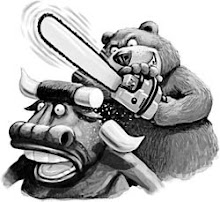The Cart and the Horse
Fed Charman Bernanke's testimony has left me wondering about cause and effect in regards to the yield curve and its "inversion". I use quotes because I see it as being flat, not inverted and I think that there is a significant difference. But that is not the issue I want to address right away. What I am pondering is the question: "Does an inverted yield curve indicate coming economic weakness or does a weakening of inherent economic conditions cause long-term yields to drop, thereby inverting the curve? In other words, is an inverted yield curve a leading or lagging (or coincident, for that matter) indicator?
The Chairman came down on the side of neither, stating (as far as I can tell from my limited attention to his comments) that the inverted yield curve doesn't matter. What he actually said was, "The inverted yield curve is not signaling a slowdown." Possibly true. But that begs the question, What is it signaling? The only other possibility is that it is a signal of global money flows so out of whack that traditional monetary indicators are useless. The more one thinks about this the more frightening the thought. But, as usual, I remain skeptical. It seems more likely that the current "flat" curve is accurately depicting an economy that is growing at a moderating pace. Gold, oil and real estate prices are high due to the massive amount of liquidity and debt that have been created in the last few years. The liquidity spigot is too large to turn off rapidly (especially with baby step rate increases). But we have finally gotten to the point of "neutrality" or some reasonable facsimile thereof. And now is the time to stop. But due to political pressures, Mr. Bernanke can't stop. If he did stop, his "credibility" would be questioned. (Why someone whose institution has decreased the value of the dollar it is ostensibly chartered to maintain by a factor of more than ten has any credibility left is beyond me.) So he will continue to raise rates to 5.0 - 5.25% and truly invert the yield curve and truly slow the economy and his only recourse will be to launch an easing campaign which will make Alan Greenspan look light a tightwad. This easing campaign will likely set off a drop in the dollar, a spike in gold prices and an inflationary monetary condition. But before we get there, Dr. Bernanke will feel the effects of an inverted yield curve in an over-leveraged environment and I doubt it will feel good. It is best to be prepared for a sharp drop in the latter half of 2006, into 2007.
Now regards my last comments on the stock market, nothing has happened to either prove or disprove my thesis that we were suffering from a failed breakout. The NDX is slightly lower, while the SPX is slightly higher. Go figure. But my read on it is this, look for a little strength, about 1700 on the NDX and 1300 on the SPX, followed by a breakdown. It would be prudent to use 1722 as a stop on the NDX and 1311 for the SPX.
The Chairman came down on the side of neither, stating (as far as I can tell from my limited attention to his comments) that the inverted yield curve doesn't matter. What he actually said was, "The inverted yield curve is not signaling a slowdown." Possibly true. But that begs the question, What is it signaling? The only other possibility is that it is a signal of global money flows so out of whack that traditional monetary indicators are useless. The more one thinks about this the more frightening the thought. But, as usual, I remain skeptical. It seems more likely that the current "flat" curve is accurately depicting an economy that is growing at a moderating pace. Gold, oil and real estate prices are high due to the massive amount of liquidity and debt that have been created in the last few years. The liquidity spigot is too large to turn off rapidly (especially with baby step rate increases). But we have finally gotten to the point of "neutrality" or some reasonable facsimile thereof. And now is the time to stop. But due to political pressures, Mr. Bernanke can't stop. If he did stop, his "credibility" would be questioned. (Why someone whose institution has decreased the value of the dollar it is ostensibly chartered to maintain by a factor of more than ten has any credibility left is beyond me.) So he will continue to raise rates to 5.0 - 5.25% and truly invert the yield curve and truly slow the economy and his only recourse will be to launch an easing campaign which will make Alan Greenspan look light a tightwad. This easing campaign will likely set off a drop in the dollar, a spike in gold prices and an inflationary monetary condition. But before we get there, Dr. Bernanke will feel the effects of an inverted yield curve in an over-leveraged environment and I doubt it will feel good. It is best to be prepared for a sharp drop in the latter half of 2006, into 2007.
Now regards my last comments on the stock market, nothing has happened to either prove or disprove my thesis that we were suffering from a failed breakout. The NDX is slightly lower, while the SPX is slightly higher. Go figure. But my read on it is this, look for a little strength, about 1700 on the NDX and 1300 on the SPX, followed by a breakdown. It would be prudent to use 1722 as a stop on the NDX and 1311 for the SPX.

